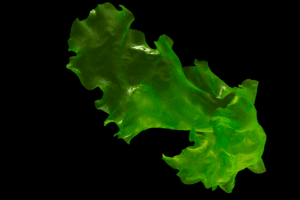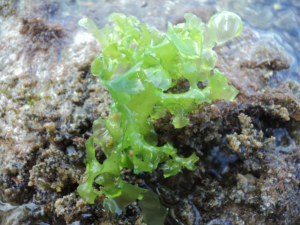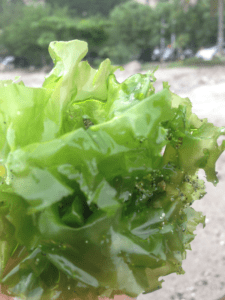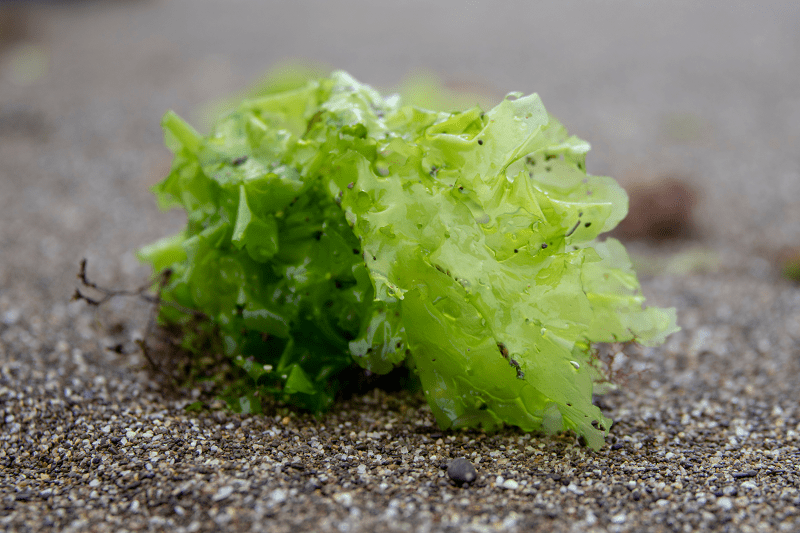If you are looking for a way to control nutrient levels in the reef tank, macroalgae is a great way to do it! You may have heard about one of the fastest growing and most versatile macroalgae: Ulva lactuca. This macro is also known as Sea Lettuce. Sea Lettuce has a host of benefits for the refugium and the display tank. This multitasking alga will work as a food source, a PH buffer, a nursery for copepods and fry, and the list goes on! In this article, we will address some of the most asked questions about growing Sea Lettuce.

What is Sea Lettuce?
Sea Lettuce, or Ulva lactuca, is green macroalgae that have coarse, lobed leaves which resemble lettuce. In the wild, Sea Lettuce can be found holding onto shells and rocks. It is also found free-floating in the water column. In shallow waters, you may be used to spotting these macroalgae in small tide pools and on rocks exposed in low tides. However, it has also been spotted at water depths of over 75 feet.
Sea Lettuce is not known for its hardiness. It is very tasty and fed upon quite easily by the local critters. Sea Lettuce will usually dominate all other macroalgae in the area. This is due to its fast-growing nature. Sea Lettuce is one of the fastest growing macros and has a whole range of great benefits in the reef tank.
These effective green macros can quickly work their way through phosphates and nitrates. These can contribute to the growth of harmful algae in the reef tank. Sea Lettuce will quickly grow to fill the available space. Therefore, it is best to grow it in your refugium rather than your display tank.
The Benefits of Using it in the Refugium
Sea Lettuce is a versatile macroalgae that can be put to several uses in the reef tank system. Rather than growing numerous, exact macros for specific purposes, it makes more sense to keep one variety that does double duty! Sea Lettuce is an easy-to-grow species which will improve water quality and diversity.
Some of the benefits of keeping Sea Lettuce in reef tank systems include:
· Sea Lettuce supports the diet of various herbivores in the display tank. So, you can have a supply of fresh seaweed at your fingertips! It is very easy to regularly transfer pieces from the refugium to the display tank.
· Helps to stabilize water parameters and outcompete nuisance algae. Sea Lettuce will help to neutralize some waste products in the reef tank. It can absorb harmful compounds such as nitrates and phosphates. This contributes to more balanced nutrient levels. The final result is less nutrients are available for nuisance algae like hair algae.
· Sea Lettuce thrives in rocky, shallow areas such as a refugium. In the ocean, Sea lettuce can be found in shallow tide pools. It can even live on temporarily exposed rocks!
· Helps to create a haven for copepods to live in! Sea Lettuce helps to protect the reef tank’s tiniest creatures. Pods will quickly populate when given the shelter of macro to hide, eat, and breed.
· Easy to grow with the right light conditions. Sea Lettuce is a very fast-growing macro when provided with appropriate lighting.
· Sea Lettuce can withstand extreme conditions. Unlike more sensitive macros, Sea Lettuce can tolerate being exposed to air during periods of low tide. This makes it more likely to adjust to

regular or routine maintenance in the reef tank system.
There are only a couple drawbacks to keeping Sea Lettuce in the refugium. But even these are manageable for most reef keepers. To efficiently grow Sea Lettuce, they require proper lighting. To maximize growth, we would recommend using a light designed specifically for growing macros. The ChaetoMax Fuge Light by Innovative Marine is an affordable and easy to use fixture. It does not generate a lot of heat either which makes it perfect for smaller refugium systems!
The other hitch that may pose an issue for some reef keepers is due to the fast-growing nature of Sea Lettuce. In the smallest systems, this can be problematic as it will quickly outcompete other macros. Sea Lettuce can also grow into plumbing and overflows very easily so regular maintenance might include clearing out the overgrowth.
How Fast Does It Really Grow?
Sea Lettuce is known for its quick-growing nature. It is so fast-growing in fact, that some have known the macroalgae to increase an additional 40% of its total mass within a day! Once it has acclimated to the new system, Sea Lettuce will need to be harvested in as little as a few weeks.

How do you grow Sea Lettuce?
Growing sea lettuce macroalgae for a reef tank refugium is quite an effortless process. This is because this species proliferates so easily. But if a system is depleted of nitrates and phosphates or has inadequate lighting, the growth rate will be slowed. The Sea Lettuce will need to be placed in an area with moderate water flow.
Here are a few of the other parameters to aim for when growing Sea Lettuce:
- Maintain a temperature in the upper 70s to lower 80s.
- Keep pH near 7.9 to 8.2; sg 1.023 – 1.025
- Strong, consistent photoperiod in the refugium.
- Keep an eye on the iron, calcium, and magnesium levels in the system.
- Give the Sea Lettuce a surface rock to attach to. This will increase the growth spread of macros in the refugium. This will also simplify the process of trimming and pruning the Sea Lettuce.
Conclusion
So, we can see there are many benefits to cultivating Sea Lettuce in the reef tank system! This macroalgae is relatively easy to grow and supplies a whole host of benefits to the reef. It is a healthy food source and so much more! Sea Lettuce serves as a hiding place, it improves the water quality, and absorbs harmful nitrates and phosphates. High levels of nitrates and phosphates can lead to nuisance algae.
Few options are as versatile or grow as quickly and as easily as Sea Lettuce! We hope that this article has been helpful in explaining some of the essentials on growing Sea Lettuce.






Leave a Reply